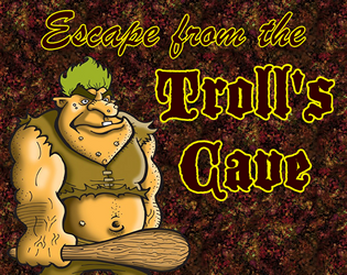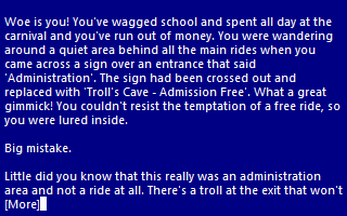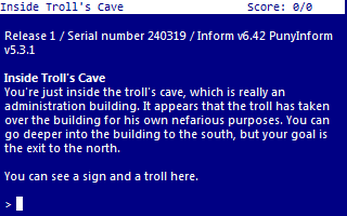
Escape from the Troll's Cave
Introduction
Woe is you! You've wagged school and spent all day at the carnival and you've run out of money. You were wandering around a quiet area behind all the main rides when you came across a sign over an entrance that said 'Administration'. The sign had been crossed out and replaced with 'Troll's Cave - Admission Free'. What a great gimmick! You couldn't resist the temptation of a free ride, so you were lured inside.
Big mistake.
Little did you know that this really was an administration area and not a ride at all. There's a troll at the exit that won't let you leave until you pay his toll, but you haven't got a cent to your name because you spent it all on fairy floss and the other rides. You need to find some money and pay the troll to return to your dull (but safe) existence outside the carnival.
Luckily for you, trolls have no pockets, so they tend to drop coins everywhere. If you look around carefully, there's a good chance that you may be able to find the money you need to pay the troll and get out of here.
Instructions
This is a traditional text adventure based on 'Cave of the Troll' by John H Doolittle.
A text adventure is a form of computer game that presents you with a story. You take on the role of the main character in the story and control that character's actions. The story has a goal and you will need to solve puzzles in order to achieve that goal. The computer tells you where you are, what you can see and what's happening around you. You can then move around, examine the things you find and manipulate those things by telling the computer what to do using simple English commands.
Commands consist of a verb phrase, optionally followed by a noun phrase. Most commands can be abbreviated to a verb followed by a noun. For example, GET THE SILVER COIN can be abbreviated to GET COIN.
If the verb is followed by a preposition, this may alter its meaning. For example, GET BROOM will attempt to pick up the broom, but GET ON BROOM will attempt to ride it.
In some cases, the verb phrase and first noun phrase may be followed by a second noun phrase. The two noun phrases are usually separated by a preposition. For example, HIT DOOR will attempt to hit the door with your hands (as you didn't specify a second noun phrase), but HIT DOOR WITH HAMMER will attempt to hit the door with the hammer. If you only use a verb and a noun, the game will generally tell you if it needs an extra phrase or implicitly try to deduce what is needed for the second phrase.
Don't panic! It's not as complicated as it sounds. Just use simple English sentences starting with a verb and it will all feel quite natural.
Movement
To move around, use commands like GO NORTH and GO SOUTH. You can move in any of the four cardinal compass directions. To save typing, movement commands can be abbreviated to N, S, E and W. You can sometimes use other movement commands such as ENTER, EXIT, IN or OUT. These will be reasonably obvious when the time comes.
Examining things
Make sure you EXAMINE everything you come across, even insignificant things like scenery and objects mentioned in room descriptions, as subtle hints and clues are scattered everywhere. To save typing, EXAMINE can be abbreviated to X. For example, EXAMINE BUILDING can be abbreviated to X BUILDING.
You can also try your other senses when it seems appropriate, e.g. SMELL, TOUCH or LISTEN. Unlike EXAMINE, these actions aren't necessary to solve any puzzles, so don't feel obligated to use them.
Manipulating objects
Apart from examining things, most of your time will be spent manipulating objects. Use commands like GET or TAKE to pick up an object, e.g. GET BROOM. Use commands like DROP or DISCARD to drop an object, e.g. DROP BROOM. Use WEAR to wear something, e.g. WEAR DISGUISE. Use REMOVE to remove something that is already worn, e.g. REMOVE DISGUISE.
To see what you're currently carrying and wearing, use INVENTORY (or I). As you're not a pack horse, you can only carry ten items at a time.
There are many other verbs that can be used to manipulate objects. These will be fairly obvious when the time comes. Common verbs include OPEN, CLOSE, LOCK, UNLOCK, READ, EAT, DRINK, PUSH, PULL and so on. Use PUT, PLACE or INSERT to put objects into containers or on supporters, e.g. PUT COIN IN SLOT.
Communicating with characters
You may encounter non-player characters in the game, not necessarily human. When you first meet new characters, in addition to examining them, you should try talking to them, e.g. TALK TO TROLL. To get further information from them, try asking them about something they've mentioned or something that seems relevant, e.g. ASK TROLL ABOUT TOLL. You can also try showing them something or giving them something, e.g. GIVE COIN TO TROLL.
Advanced features
You can use IT to refer to the noun used in the previous command, e.g. EXAMINE SIGN. READ IT. You can also use HIM, HER and THEM for male, female and plural objects respectively.
You can refer to multiple objects by separating the objects with AND, e.g. GET NICKEL AND DIME. Using IT in the next command will only refer to the last of those objects, e.g. EXAMINE IT in this example will refer to the dime.
You can use ALL to refer to all the appropriate objects with GET and DROP, e.g. GET ALL to get everything in the current location, GET ALL FROM TABLE to get everything on the table, DROP ALL to drop everything you're holding.
When using ALL, you can use EXCEPT or BUT to exclude some objects, e.g. DROP ALL EXCEPT BROOM.
Finally, you can enter multiple commands on the same line by separating them with a period, e.g. UNLOCK DOOR WITH KEY. OPEN IT.
Other commands
Use LOOK (or L) to refresh the display.
Use VERSION to get the game version. Use ABOUT or INFO to get background information and credits for the game. Use CREDITS to get the credits only.
Use SAVE to save your progress. Use RESTORE to restore a previously saved game.
Use UNDO to undo the last move. This is handy if you change your mind or make a mistake. You should not be able to get killed in this game nor should you be able to get into an unwinnable situation. (UNDO is not available with the z3 version of the game.)
Use SCORE to get your current score and number of turns taken.
Use AGAIN (or G) to repeat the last command.
Use WAIT (or Z) to do nothing apart from pass the time.
Use HELP to get a brief reminder of how to play the game or HINT to get a context-sensitive hint related to the current location.
Use RESTART to restart the game from the beginning. Use QUIT (or Q) to quit without restarting.
Keyboard shortcuts
Some interpreters have keyboard shortcuts. If you are using an interpreter on a computer with a conventional keyboard, most will allow you to press the up and down arrow keys to cycle through your past commands. This is handy if you want to repeat the previous command or correct a typo.
Scoring
You score 10 points for each coin you find and 15 points for each coin you give to the troll.
Playing the game
There are two ways to play the game:
Click the 'Run game' button (above) to play the game in a browser.
Download the z5 file and play the game using a z-code interpreter (see below). A z3 file is also provided for old 8-bit and 16-bit computers that can't interpret a z5 file.
Finding a z-code interpreter
There are a variety of z-code interpreters for all the major platforms, as well as many minor and retro platforms. There are far too many to list here. The best source of downloads is probably the Interactive Fiction Archive. Navigate to infocom/interpreters for z-code interpreters and interpreters-multi for interpreters that interpret both z-code games and other formats.
Common z-code interpreters
Android: I recommend Hunky Punk from Google Play. (There are others, as well.)
iOS: I recommend Frotz from the Apple App Store. (There are others, as well.)
Linux: See the links above.
Mac: See the links above.
Windows: I recommend Windows Frotz from the infocom/interpreters link above. (There are others, as well.)
Credits
Inform 6 compiler, language and library originally written by Graham Nelson and now maintained by David Griffith, David Kinder, Andrew Plotkin et al.
PunyInform library written by Johan Berntsson and Fredrik Ramsberg based on the Inform 6 library.
ZAbbrevMaker written by Henrik Åsman.
Parchment interpreter written by Dannii Willis et al.
Original concept by John H Doolittle.
Game design and coding by Garry Francis.
Play testing by Hidnook, Jade J Aincioa, John H Doolittle and Timur Ozturk.
| Status | Released |
| Platforms | HTML5, Windows, macOS, Linux, Android |
| Authors | DrDooriddle, Garry Francis |
| Genre | Interactive Fiction |
| Tags | inform-6, parser, punyinform, Retro, text-adventure, Text based, troll |
| Average session | About a half-hour |
| Languages | English |
| Inputs | Keyboard |



Comments
Log in with itch.io to leave a comment.
I played the original first as I found it when browsing games with BASIC source code on the Interactive Fiction Database, thought it had an interesting premise, and converted the code to SmileBASIC on the Nintendo 3DS, but I liked the additions made in this version, particularly all of the troll's dialogue, and the addition of the EXAMINE command!
I'm glad you liked it. The other games in the series also have many improvements that I think you'll like.
I definitely plan on doing so!
Fun game! Short.
Glad you liked it. It's intentionally easy, as it's meant to be an introduction to text adventures. Try The Babysitter next.